| |
The
Living Nightmare ...
The Honourable
J.L. Ralston, speaking in the House of Commons at
Ottawa: "The defense of Hong Kong is in accordance
with the finest traditions of the Canadian Army. All
ranks fought it out to the last and more cannot be
asked of any man."
In the early morning hours of
Christmas Day the Japanese approached St. Stephen's Hospital.
Doctors and nurses stepped forward to surrender and were shot or
bayoneted where they stood. The Japanese stormed into the
hospital, killing and beating staff members, beating and
bayoneting the wounded as they lay helpless in their beds. The
acts were unspeakable. Eye witness accounts tell the terrible
story.

Artist's
Rendition of the Massacre at St. Stephen's Hospital - Christmas
Day, 1941
Rifleman Sydney Skelton, 19 years old, of
"D" Company of the Royal Rifles of Canada had been wounded when
he and two other soldiers ran into a Japanese machine-gun nest.
His two companions were killed instantly. Skelton was hit by the
heavy caliber machine-gun bullets and flung down an embankment
which provided cover until he was rescued. Badly wounded he was
taken to St. Stephen's Hospital.
Rfm. Sydney Skelton, of "D" Coy of the
Royal Rifles, recounts:
"I was sharing a 10' x 12' room in St. Stephen's Hospital with
about 40 other wounded. The hospital doubled as a prison after
the battle was over and we had laid down our arms. I had been
wounded by machine-gun bullets in my right leg and took another
in the arm. I had been waiting for surgery when I was captured
so I was given only a hospital blanket when the Japs took the
hospital. I had been given some pre-operative anesthetic and was
pretty groggy but certain things you never forget."
What he never forgot were the sounds of the conquering Japanese
Infantry celebrating their victory that Christmas Day.
Rfm. Skelton continues:
"The Japs stormed the hospital throwing grenades and bayoneting
the wounded. I had rolled under a bed and lay as still as I
could. A Jap turned me over, kicked me in the face, and tore off
my bandages. I didn't move, or make a sound. The guy must have
thought I was dead and took off. I heard screams coming from
outside, terrible screams I can still hear in my head twenty
years later. I saw a Jap coming into the hospital and take men
outside at random. One of the wounded they dragged from his bed,
cut off his ears, and ripped out his tongue. Then they took him
outside and shot him. There was a lull in the din and he heard a
British officer shout: "If you can walk or crawl to the door you
may be allowed to live."
At this point Skelton tried to crawl to
the door: "I was really confused from the anesthetic and I
started to crawl, dragging my blanket, towards the door. A guy
just ahead of me, a Hong Kong Volunteer, with a clasp knife in
his belt, but his hands raised, was bayoneted as soon as he went
out the door. The Padre grabbed me and slapped me to my senses.
I'm alive today, thanks to him." A Japanese officer entered the
hospital, saw Skelton with his wounds bleeding. He tore off
Skelton's watch, hit him with the flat side of his sword and
ordered him to go upstairs. Though badly wounded, Skelton
crawled up the stairs and into a room that would be his prison
for the next two days.
Skelton spent nearly four years as a captive, first in Hong Kong
and later in Japan where he worked as a slave labourer in a coal
mine. Somehow, he made it home, where he lived in Scarsboro,
Ontario. In a 1961 interview, he said: "Twenty years have
passed, but I can never forget Christmas, 1941."
________________________________________
|
